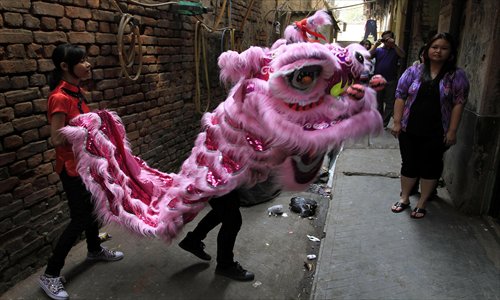HOME >> WORLD
Economic exodus
By Sujoy Dhar Source:Global Times Published: 2013-8-27 0:38:01

Chinese watch a dragon dance in an alley during celebrations marking the Chinese New Year in Calcutta, India in February 2012. Photo: IC
In Kolkata's eastern fringe, where tall, shiny office buildings form a jagged modern day skyline, a rather narrow, squalid and chaotic road leads to the city's famous little Chinatown at Tangra.
While this unkempt neighborhood seems caught in a time warp, the eateries lined up on either side of the road are like gastronomic magnets to Kolkata's sophisticated foodies.
Here at Tangra, one of the city's best known Chinese food destinations is a Beijing restaurant whose 59-year-old owner Monica Liu is one of the few successful Chinese entrepreneurs in the city who stayed back despite her compatriots seeking greener pastures in foreign lands.
"I also wanted to go at one point but then realized it was too late. I stayed back and the warm Bengalis of Kolkata are such well wishers for me," says Liu, who with her sons run famous Chinese food joints in Tangra and three others called Kim Ling, Tung Fong and Mandarin in other parts of Kolkata, India's eastern city of about 15 million people.
Chinese in Kolkata thus dwindled to less than 4000 now though the city's cosmopolitan mosaic has been enriched by the community for generations.
As the credits rolls on screen in the old Bengali black and white era films, several Chinese names could be spotted as make up artists.
Forced departure
Faced with bleak business prospects since the 1980s, the Chinese started leaving for opportunities in countries and regions of Canada, US, Europe, and even the Middle East.
"I do not want to go since I love Bengalis and the city. The family from my side is still in India while my husband's brothers and sisters left the city long back," says Liu.
Since its inception, Kolkata and its adjoining areas have been a confluence of various cultures and communities. The natives are as much of an influence on the city's socio-cultural architecture as the foreigners who came from distant lands and gave the "City of Joy" its cosmopolitan character. Of all the communities who came here over the centuries, only the Chinese are still a visible minority in Kolkata.
However, this once thriving community's population is dwindling fast, though the city is still famous for its Chinatown at Tangra and the lip-smacking array of Chinese food joints there. From a population of nearly 350,000 in 1962, the number of Chinese left in the city now is less than 4,000.
In 1778, Young Atchew (Yang Tai Chow) became the first Chinese to set foot in Achipur on the banks of the Hooghly River where he had set up a sugar mill that only lasted five years. But that didn't deter this group of vigorous people, who gradually flourished in other parts of Kolkata.
Terity Bazar in central Kolkata and Tangra are the two main places where the Chinese communities have settled, specializing in trades like tanneries, dentistry and beauty parlors.
Connected by trade
Restaurants are another mainstay of Chinese businesses in Kolkata and the city just loves to binge on Chinese delicacies. In British India, Kolkata sent opium and later cotton to China while Canton reciprocated with tea and silk. Trade declined but the connection lingered.
Driven by famine in central China, the Hakka community began migrating to this port city.
Cantonese Chinese came and settled along Chitpore Road and near Chhatawala Gully in north Kolkata.
Now this community is moving out of the city, with the young generation seeking bigger opportunities in other countries due to the adverse business atmosphere. Notwithstanding the migration, even today many Chinese are still trying hard to keep their traditional presence alive here.
Difficult resettlement
While the Chinese in Kolkata are leaving in hordes for Western countries, resettlement abroad has not always been easy, said 43-year-old Joseph Kou, who went to Canada in 1997 but after more than a decade came back to Kolkata, since the economic slowdown abroad hit him badly.
"I am back in Kolkata and want to stay here. When I left, everyone was talking about the big opportunities in countries like Canada. Everyone said you can make money there. I went to Toronto and I started working in car companies on the spare parts assembly section," Kou said. "But then things started turning bad there owing to the economic situation."
Economic opportunity abroad and shrinking opportunities in Kolkata owing to competition from big businesses were the main reason for the exodus.
In fact, from 250 Chinese-owned shoe shops in the 1970s, Kolkata now has around 40 such shops.
"The main reason for Chinese in Kolkata leaving was the lack of jobs here. There was no opportunity to make money since there was huge competition from big companies in our traditional trades," said Kou.
"So while old people stayed back, the new generation left Kolkata. Young Chinese are now well educated people and they have good degrees.
So they will go abroad and study in universities there or get a job," said Kou.
"So while old people stayed back, the new generations left Kolkata. Young Chinese are now well educated people and they have good degrees. So they will go abroad and study in universities there or get a job," sums up Kou.
Posted in: Asia in Focus